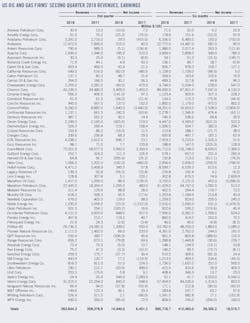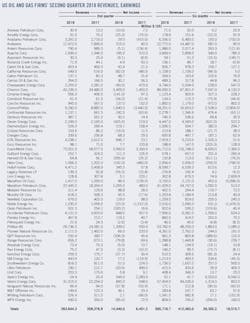Second-quarter results benefited from higher oil prices, production
A sample of 60 US-based oil and gas producers and refiners recorded a total net income of $14.44 billion in this year’s second quarter compared with $6.45 billion in the previous year’s second quarter. Collective revenues totaled $263.64 billion for the quarter compared with $208.37 billion a year ago.
The year-over-year improvement in oil and gas producers primarily reflected higher realized crude oil prices, higher crude oil production, lower impairment charges, and lower tax expenses offset, at least in part, by lower asset sales gains.
Brent crude oil prices averaged $74.50/bbl in the second quarter compared with $49.67/bbl in second-quarter 2017 and $66.81/bbl in this year’s first quarter. West Texas Intermediate averaged $68.03/bbl in this year’s second quarter, $48.24/bbl in second-quarter of 2017, and $62.80/bbl in this year’s first quarter.
WTI traded at a wider discount to Brent in this year’s second quarter relative to second-quarter 2017 and this year’s first quarter because of strong US production growth, limited capability to handle incremental light crude in the US refining system, and infrastructure constraints.
US drilling activity accelerated during the quarter. According to data from Baker Hughes, the number of rigs drilling for oil in the US increased to 858 at the end of June from 797 at the end of March.
According to the US Energy Information Administration, US crude oil production averaged 10.53 million b/d for this year’s second quarter. This compares with 9.11 million b/d for the same quarter in 2017 and 10.23 million b/d for this year’s first quarter.
Henry Hub natural gas spot prices averaged $2.86/MMbtu in this year’s second quarter compared with $3.08/MMbtu in the same quarter in 2017, while US dry gas production for the quarter increased to 7.31 tcf from 6.55 tcf a year earlier, according to EIA.
Results of US refiners also benefited from higher distillate margins and stronger crude oil discounts during the quarter.
According to Muse, Stancil & Co., refining cash margins in this year’s second quarter averaged $21.09/bbl in the Midwest, $3.34/bbl on the West Coast, $10.52/bbl on the Gulf Coast, and $3.03/bbl on the East Coast. In the same quarter of the prior year, these refining margins were $9.94/bbl, $3.28/bbl, $8.66/bbl, and $5.01/bbl, respectively.
A sample of 12 companies based in Canada, including oil and gas producers and pipeline operators, reported combined earnings of $3.55 billion (Can.) in this year’s second quarter. In the second quarter of last year, this group’s combined earnings were $6.13 billion. The decrease was largely due to a dramatic drop in Cenovus Energy Inc.’s results.
US oil and gas producers
Chevron Corp. announced net earnings of $3.4 billion for the second quarter, up from $1.5 billion in the same quarter in 2017. Included in the current quarter was a receivable write-down of $270 million charged to operating expense. Foreign currency effects increased earnings in the second quarter by $265 million compared with an increase of $3 million in the same quarter in 2017.
World oil-equivalent production for this year’s second quarter was 2.83 million b/d, up from 2.78 million b/d from a year ago. Growth from project start-ups and ramp-ups was partially offset by asset sales and production entitlement effects.
US upstream operations earned $838 million in this year’s second quarter compared with a loss of $102 million in the same quarter a year ago. Net production of 739,000 boe/d in this year’s second quarter was up 38,000 b/d from a year ago.
International upstream operations earned $2.46 billion in this year’s second quarter compared with $955 million a year ago. Net production of 2.09 million boe/d in this year’s second quarter was up 8,000 b/d from the same quarter a year ago.
International downstream operations earned $181 million in this year’s second quarter compared with $561 million in second-quarter 2017. The sale of the company’s Canadian refining and marketing business in third-quarter 2017 contributed to lower margins and operating expenses.
ExxonMobil Corp. reported net income of $3.95 billion in this year’s second quarter compared with net income of $3.35 billion for the prior year’s second quarter. Capital and exploration expenditures were $6.6 billion, up 69% from the prior year, reflecting key investments in Brazil, the Permian basin, and Indonesia.
The company’s production was 3.65 million boe/d, down 7% from second-quarter 2017, primarily due to entitlement effects and divestments. US tight oil growth in the Permian and Bakken continued, reaching over 250,000 boe/d in the second quarter, an increase of 30% from the same period last year. Hebron field in Canada continued to exceed expectations, ramping up to 25,000 boe/d in the second quarter.
Natural gas volumes decreased 10%, excluding entitlement effects and divestments, largely due to a continuing shift in US unconventional development from dry gas-to-liquids and to downtime in Qatar, Australia, and Papua New Guinea.
ExxonMobil’s overall refining throughput and earnings were negatively impacted by heavy turnaround and maintenance activities during the quarter.
ConocoPhillips recorded net income of $1.64 billion for this year’s second quarter compared with a net loss of $3.44 billion for 2017’s second quarter, thanks to the absence of noncash impairments of APLNG, San Juan, and Barnett, and current-quarter higher realized prices, partially offset by the absence of the gain on the Canada disposition.
Second quarter production excluding Libya was 1.21 million boe/d, down from 1.42 million boe/d from a year ago. Excluding the impact of closed dispositions, underlying production increased 58,000 b/d, or 5%. The increase came primarily from growth in the Big 3 (Eagle Ford, Bakken, and Delaware) unconventional assets and other major projects, which more than offset normal field decline. Production from the Lower 48 Big 3 unconventional plays increased 37% from a year ago.
Devon Energy Corp. posted a net loss of $425 million in this year’s second quarter compared with net income of $219 million a year earlier. The company’s operating cash flow in the quarter was impacted by several nonrecurring or unusual items, including a noncash foreign exchange loss, restructuring charges, EnLink’s reclassification to discontinued operations, and working capital changes.
The company’s production was 541,000 boe/d in the second quarter, nearly flat with the second quarter of 2017. Oil accounted for the largest component of the product mix at 45% of total volumes. In the quarter, light oil production in the US averaged 136,000 b/d, a 12% increase compared with this year’s first quarter.
EOG Resources Inc. reported net income of $696.7 million for this year’s second quarter, up from net income of $23.1 million in second-quarter 2017.
The company’s crude oil production for this year’s second quarter was 384,6000 b/d, up from 334,000 b/d in the same quarter a year ago. Total company production increased 16% in this year’s second quarter compared with the same quarter last year. Growth in the Delaware basin, Eagle Ford, and Powder River basin drove EOG’s strong performance. The company maintained its target for 18% crude oil growth for full year 2018.
Hess Corp. recorded a net loss of $142 million for this year’s second quarter compared with a net loss of $460 million for the same quarter in 2017. The improved results reflect higher realized crude oil selling prices, lower operating costs, and depreciation, depletion, and amortization expense, partially offset by lower production volumes, primarily due to asset sales.
US refiners
Valero Energy Corp. reported net income of $845 million in this year’s second quarter compared with $548 million for the same quarter a year ago. The refining segment reported $1.4 billion of operating income for this year’s second quarter compared with $945 million for second-quarter 2017. The increase was driven mainly by higher distillate margins and wider discounts for sour and domestic sweet crude oils vs. Brent.
Refinery utilization was 93%, and throughput volumes averaged 2.9 million b/d in this year’s second quarter, which is 121,000 b/d lower than second-quarter 2017 due to maintenance in the North Atlantic and US Gulf Coast. The company exported a total of 409,000 b/d of gasoline and distillate during this year’s second quarter.
Marathon Petroleum Corp. reported second-quarter net earnings of $1.06 billion for 2017 compared with $483 million in second-quarter 2017.
The refining and marketing segment income from operations was $1.03 billion compared with $562 million in second-quarter 2017. The year-over-year increase was primarily driven by positive Midwest and Gulf Coast crack spreads on an ex-RIN basis as well as wider WCS and WTI based crude differentials. These favorable effects more than offset the $232 million reduction in segment results associated with the Feb. 1 dropdown transaction.
Andeavor reported second-quarter earnings of $515 million compared with $40 million in the same quarter a year ago. This year’s second-quarter results include $30 million of integration costs related to Western Refining and transaction costs primarily related to the strategic combination with Marathon Petroleum.
The company’s refining segment operating income was $607 million for this year’s second quarter compared with $45 million in the same quarter in 2017. The company’s refining margin was $1.4 billion for this year’s second quarter compared with a refining margin of $768 million in second-quarter 2017. Refining utilization was 96% for this year’s second quarter compared with 91% for the same quarter in 2017.
Phillips 66 announced second-quarter earnings of $1.34 billion compared with $524 million in this year’s first quarter.
Refining second-quarter net income was $910 million compared with $91 million in this year’s first quarter. The increase was due to higher realized margins and volumes as well as lower turnaround costs. Realized margins for the quarter increased to $12.28/bbl from $9.29/bbl in the first quarter, reflecting improved market crack spreads and wider crude differentials. Gasoline and distillate market cracks were up 20% and 4%, respectively. The widening of the Brent–WTI spread, larger discounts on US inland crudes, and improved heavy crude differentials all contributed to increased realized margins.
Phillips 66’s worldwide crude utilization rate was 100%, up from 89% in the prior quarter. Pretax turnaround costs for the second quarter were $60 million, down from $245 million in the first quarter.
Canadian firms
All financial figures in this section are presented in Canadian dollars unless noted otherwise.
Suncor Energy Inc. recorded second-quarter earnings of $972 million, up from $435 million in the same quarter last year, reflecting higher crude oil pricing and increased refinery margins, higher in situ and Syncrude production, and the addition of production from the Fort Hills and Hebron projects. The increase was partially offset by the impact of major planned maintenance at the company’s oil sands operations and its refineries, the addition of operating costs, and lower capitalized interest. Meantime, net earnings for this year’s second quarter included a $218 million unrealized aftertax foreign exchange loss on the revaluation of US dollar denominated debt.
Suncor’s total upstream production was 661,700 boe/d in this year’s second quarter compared with 539,100 boe/d in the same quarter in 2017. Oil sands production increased from the prior year’s second quarter. However, sweet synthetic crude oil (SCO) production was negatively impacted by the first major planned turnaround of Upgrader 1 since moving to a 5-year cycle.
Cenovus Energy reported a second-quarter loss of $418 million compared with earnings of $2.62 billion in second-quarter 2017. Results of 2017’s second quarter included results from Cenovus’s legacy conventional segment, which is now classified as a discontinued operation. Meantime, results from this year’s second quarter reflected realized risk management losses of $697 million, largely due to hedging contracts established in 2017 to provide downside oil price protection based on market conditions at the time.
Cenovus’s oil sands production reached almost 390,000 b/d in the second quarter, 49% higher than the same period of 2017, and record low oil sands operating costs of $7.32/bbl. Refining and marketing operating margin reached $357 million compared with $20 million in second-quarter 2017.
Husky Energy Inc.’s net earnings were $448 million compared to a net loss of $93 million in second-quarter 2017. Adjusted net earnings were $474 million, up from $10 million in the year-ago period.
Husky’s upstream production averaged 295,500 boe/d compared with 319,500 boe/d in the year-ago period, which was prior to asset dispositions in Western Canada during second-half 2017. Lower production in this year’s second quarter also reflects seasonal maintenance and weather-related impacts as well as the expiry of the company’s participation in Wenchang in the Asia Pacific region in the fourth quarter of 2017.
The company’s downstream throughput was 355,000 b/d in the second quarter compared with 316,000 b/d in the same quarter a year ago.
About the Author
Conglin Xu
Managing Editor-Economics
Conglin Xu, Managing Editor-Economics, covers worldwide oil and gas market developments and macroeconomic factors, conducts analytical economic and financial research, generates estimates and forecasts, and compiles production and reserves statistics for Oil & Gas Journal. She joined OGJ in 2012 as Senior Economics Editor.
Xu holds a PhD in International Economics from the University of California at Santa Cruz. She was a Short-term Consultant at the World Bank and Summer Intern at the International Monetary Fund.
Laura Bell-Hammer
Statistics Editor
Laura Bell-Hammer has been the Statistics Editor for the Oil & Gas Journal since 1994. She was the Survey Editor for two years prior to her current position with OGJ. While working with OGJ, she also was a contributing editor for Oil & Gas Financial Journal. Before joining OGJ, she worked for Vintage Petroleum in Tulsa, gaining her oil and gas industry knowledge.




